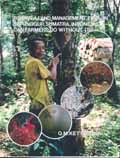| Thesis |
 |
|
| Title | Fire as a land management tool in sepunggur Sumatra, Indonesia, can farmers do without it? | | Author | Quirine M Ketterings | | Year | 1999 | | Academic Departement, University | Ohio State University | | City | Ohio | | Number of Pages | 285 | | Departement | Environmental Science | | Degree | PhD | | Call Number | TD0062-04 | | Keywords | Fire,Land Management, Sepunggur, Sumatra, Indonesia, Farmers |
|
| Abstract: |
| Small-scale (2-5 ha) farmers in Sepunggur, Sumatra, Indonesia, use fire because it is the cheapest and quickest tool for land clearing . Other benefits, as perceived by the farmers, are an increased soil fertility ascribed to ash addition, soil structure improvement, and a reduction of pests, diseases and regrowth of trees, shrubs and weeds. Extreme pollution from land-clearing fires in 1997, however, emphasized the need for alternative management practices. Slash-sell wood-and-bum is an alternative that could reduce smoke production because large wood stock would be removed and sold before burning. Its viability will, in part, depend on tax policies and the effects of a reduction in fire intensity on fertility of the P-deficient Oxisols of Sepunggur.
High intensity broadcast fires (>500'C) increased exchangeable bases and reduced Al-toxicity; however, net losses in soil C, N and available P (measured as BrayP) occurred. Medium intensity fires (250-500'C) led to smaller gains in exchangeable bases and losses in C and N while a gain in available P occurred. The smallest gains in exchangeable bases and losses in C and N were recorded for low intensity fires (<250'C). However, these fires resulted in the largest available P increases.
Ash addition led to the gains in exchangeable bases. Losses in C and N were determined by heat exposure which was also responsible for part of the increase in pH and decrease in Al toxicity. The increase in available P under low intensity fires was obtained by both ash addition and heat exposure. At high intensity, the positive effects of ash addition were outweighed by the negative effects of heat exposure.
Heat exposure transformed some kaolinite and gibbsite into an amorphous phase and converted goethite into maghemite. The clay textured soil became sand textured upon combustion. These mineralogical and physical changes increased the maximum sorption capacity and P affinity, in part due to an unexpected increase in specific surface
area. Heat exposure shortened the period of elevated P levels and resulted in a long-term negative effect on soil fertility.
Low intensity fires are preferred from both an environmental and a soil fertility point of view. Slash-sell wood-and-burn is an alternative that will lead to less intense fires. However, its success will depend on the removal of tax levies on the sale of wood. |
|